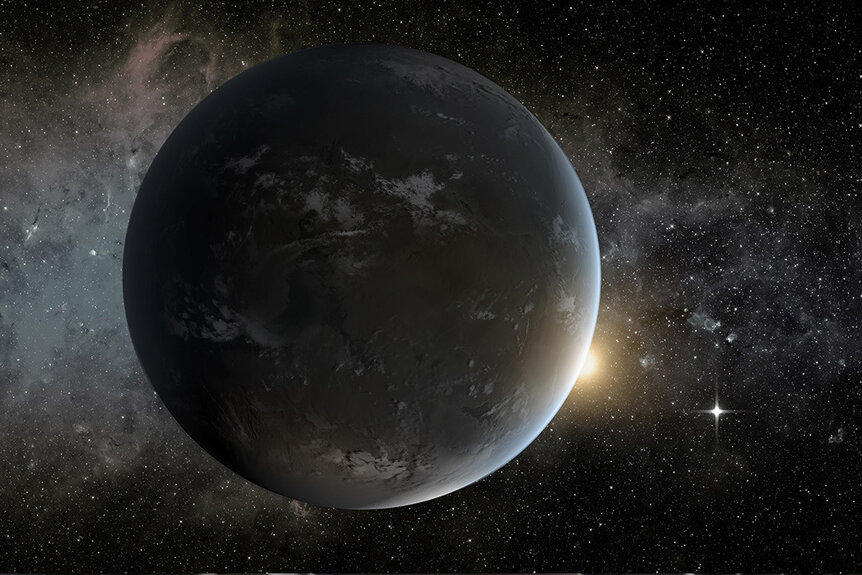Create a free profile to get unlimited access to exclusive videos, sweepstakes, and more!
The crew of 'The Ark' could have two new nearby Earth-like worlds to explore
Just a short jaunt across an interstellar pond.

In the aftermath of a global catastrophe, humanity sends its last hope for survival into deep space on a ship called the Ark One. The crew, adrift on rocky cosmic seas, is searching for humanity’s next home on a planet orbiting another star. That’s the premise of the upcoming science fiction adventure The Ark, slated to hit SYFY in February 2023.
If some planetary disaster occurred today, requiring us to jump on the last lifeboat to another cosmic island, we’d be in a bit of trouble. With our current technology, it would take thousands of years to get to the next closest star, and we’d have to survive the apathetic malice of space the whole time. That said, we’d be lying if we said we hadn’t thought about it. Assuming reasonable advancements in space travel technologies, it seems within the realm of possibility that our descendants, a few hundred years into the future or so, might set their sights on distant worlds.
Space is big and homes ready to move into are few and far between. If future space explorers do decide to make the trip to one of our stellar neighbors, they’re going to need some good target worlds. Luckily, recent research has revealed two new potential destinations. An international team of astronomers have identified not one but two Earth-like planets orbiting the star Gliese 1002. Their findings have been accepted for publication in the journal Astronomy & Astrophysics. Gliese 1002 is a relatively small star by our standards, a red dwarf only about an eighth the mass of the Sun, but that just means everyone has to get a little cozier to keep warm. And at a distance of only 16 light years from us, it isn’t too far from home, universally speaking.
RELATED: Astronomers identify twin water worlds 218 light years from Earth
To be sure, 16 light years is a long way. It’s roughly a million times the distance from the Earth to the Sun and even our fastest machines would take a while to get there. The Parker Solar Probe, the fastest spacecraft our species has ever devised, would take just shy of 30,000 years to get there at its top speed of 364,660 miles per hour. If we’re planning to leave home, we’re going to need a faster means of transportation, but it makes sense to start planning the trip now.
“Nature seems bent on showing us that Earth-like planets are very common. With these two we now know seven in planetary systems quite near to the Sun” said Alejandro Suárez Mascareño, first author of the new study, in a statement released via Eurekalert.
The planets, dubbed GJ 1002b and GJ 1002c (we’re going to need better names to put on the travel brochures), have masses 1.08 and 1.36 times that of Earth, respectively, and they both lie within their parent star’s habitable zone. That doesn’t necessarily mean they’d be comfortable, but it does mean they’re at the right distance where liquid water could reasonably exist on the surface.
The planets were identified through a collaboration between two instruments. The first is the Calar Alto high-Resolution search for M dwarfs with Exoearths with Near-infrared and optical Echelle Spectrographs. The second is the Echelle Spectrograph for Rocky Exoplanet and Stable Spectroscopic Observations. Those are mouthfuls, both of them, so scientists call them CARMENES and ESPRESSO for short. CARMENES did the initial observations between 2017 and 2019, then ESPRESSO observed through 2021. Both instruments use faint changes in light at different sensitivities to gather data from distant objects. Combining data from both instruments allowed scientists to analyze the planets with a level of detail not possible using any other instruments.
RELATED: Astronomers are watching an exoplanet slowly fall into its star
While a trip to Gliese 1002 isn’t in our near future, their proximity to us does make them good candidates for further study, including characterizing their atmospheres. Using spectrometers to pick up subtle information in reflected light, scientists can figure out what sorts of chemical elements are present in distant alien skies. If they turn out to have oxygen at the right concentrations and the air is otherwise non-toxic, that would be one more tick in the habitability box. That isn’t to say, however, that either world would truly feel like home.
GJ 1002b orbits its star every 10 days and 1002c orbits every 21 days. If Earth orbited that quickly we’d have to deal with chaotic weather as the seasons go through an entire cycle every few weeks. Of course, climate and weather also depend on things like atmospheric composition, water content, and whether the planets are tidally locked, among other things. Those characteristics remain a mystery and probably will be for quite some time, but it’s unlikely it would feel like home. Of course, if you’re the thousandth generation on a generation ship that launched from Earth thousands of years before you were born, you won’t know what you’re missing.
Before the space race for a new planet begins, check out the original Space Race between the United States and the USSR, now streaming on Peacock!































